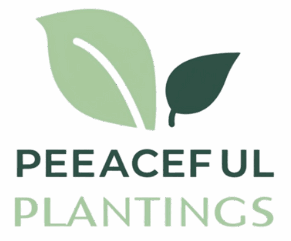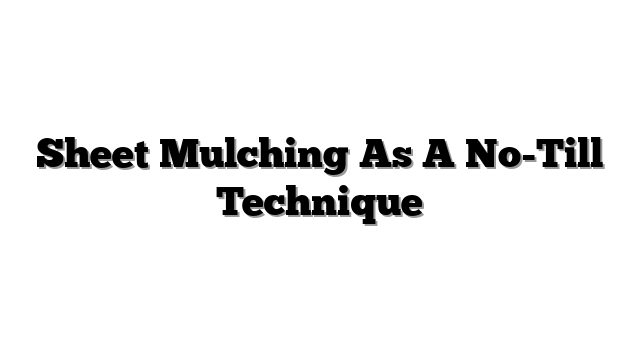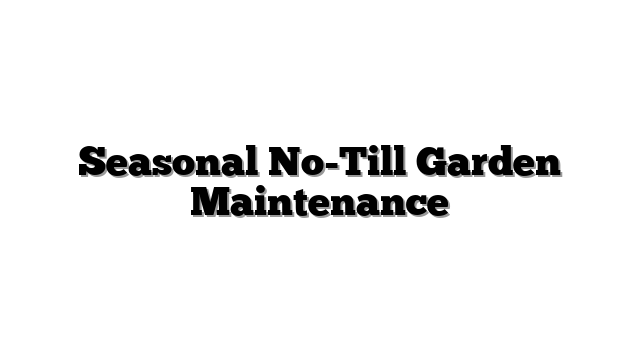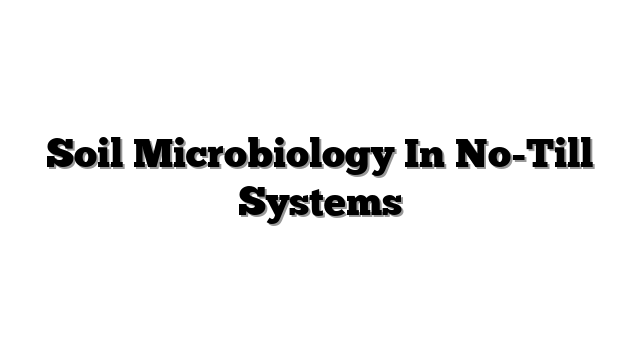Benefits Of No-Till Gardening For Soil Health
Benefits of No-Till Gardening for Soil Health: Comprehensive 2025 Guide
Gardening can feel like a fight. You dig hard soil. Your back hurts later. Plants do not grow well. You try everything. Still, your garden struggles. What if there was a better way?
Imagine working with nature. Your soil gets better. Your plants get strong. You do less hard work. This is no-till gardening. It changes how we garden. It helps the earth too.
This article explores a new path. We look at no-till gardening benefits. We see how it helps soil health. We explain why it works. We share its many good points. We show how to start. We cover what to expect. We include ideas for 2025.
Join us on this journey. Learn about no-till. See its deep impact. Discover easier garden tasks. Find out about its future. Build healthy soil. Grow happy plants. This guide is for you. It helps beginners. Experienced gardeners learn too.
What Exactly is No-Till Gardening?
No-till gardening means no digging. You do not turn the soil. You leave the soil layers alone. This is different from old ways. Old ways use a machine. A tiller churns the ground.
Why avoid digging? Tilling hurts the soil. It breaks up soil structure. Good soil has clumps. Tilling makes it small bits. It kills soil biology. Tiny life lives in soil. Soil microbes are important. Good fungi live there too. Tilling kills them.
Tilling brings up old seeds. These seeds are weeds. Weed management gets harder. Tilling can make soil hard. A hard layer forms below. This is soil compaction. Water does not drain well. Soil washes away easily. This is soil erosion.
The no-till idea is simple. Build soil from the top. Add good things to the surface. Use layers of organic matter. Compost is great. Mulch works well. Nature does the digging. Worms tunnel down. Roots grow deep. Fungi connect everything. This builds soil structure. Nutrients move easily.
It is an old farming method. People used it long ago. It is like regenerative gardening. It fits sustainable farming ideas. It works with nature’s plan.
The Profound Benefits for Soil Health
No-till helps soil a lot. It is the main reason to do it. Benefits of No-Till Gardening for Soil Health are many. It makes soil truly healthy soil.
Soil structure improves greatly. Undisturbed soil forms strong clumps. These clumps create air spaces. Air and water move freely. Soil quality becomes excellent. Healthy soil grows happy plants.
Soil biology booms underground. A tiny world lives there. Soil microbes are busy workers. Fungi help plants get food. Worms dig tunnels. Insects live in the soil. They all break down matter. They cycle nutrients. This is the soil food web. Beneficial organisms thrive.
Adding layers builds soil. Compost adds rich food. Mulch protects the surface. Organic matter increases. This feeds the soil life. Soil fertility goes up naturally.
Water management gets better. Good soil structure helps. Organic matter holds water. Water retention is higher. Soil stays moist longer. It also drains well. Water goes down, not sideways. Less runoff happens. This reduces soil erosion.
Soil compaction is less likely. No machine pushes down. The soil stays loose below. Surface cover stops rain impact. Rain does not compact soil. Wind does not blow soil away. Soil erosion stops.
Soil biology feeds plants. They make nutrients ready. Plants find food easily. Nutrient availability is high. You need less outside food. Soil fertility builds over time. Healthy soil makes strong plants.
Advantages Beyond the Soil
No-till helps the gardener too. It makes your work easier. Reduced garden maintenance is a big plus.
You do not dig fields. It saves your back. Less physical effort is needed. Planting is simpler. You part the mulch. You make a small hole.
Weed management improves. Fewer weed seeds rise up. Thick mulch blocks sunlight. Weeds are easier to pull. Weed control gets better later. It takes some time.
Good bugs find a home. Undisturbed soil is safe. Mulch gives them cover. Ground beetles live there. Spiders hunt pests. These are beneficial organisms. They help control bad bugs.
You can save money. You buy less fertilizer. Soil feeds plants naturally. You use less water. Soil holds water better. You do not need a tiller machine. Long-term costs go down.
It helps the environment. Soil stores carbon. This helps the air. You use less fuel. Sustainable gardening is good for earth. Regenerative gardening heals land.
Getting Started with No-Till Gardening
Starting no-till is not hard. You can do it step by step. It is good for gardening for beginners. Experienced gardeners can change.
First, look at your yard. See your soil type. Check how water drains now.
To start a new bed:
1. Get cardboard. Remove tape and labels.
2. Lay cardboard on the ground. Cover grass or weeds. Overlap the edges well.
3. Add thick compost. Put several inches down.
4. Add a thick layer of mulch. Use straw or wood chips. Make it 3-4 inches deep.
5. Wait a few months. The layers break down. This builds soil. Soil preparation is done. Your garden bed is ready. This is sheet mulching.
For an existing bed:
Stop digging it. Add compost on top each year. Add mulch too. Let nature take over.
Use cover crops too. Plant them after harvest. They grow green leaves. They add organic matter. Their roots improve soil structure. Cut them down in spring. Leave them on top. Do not dig them in.
Choosing your mulch matters. Straw is cheap. Wood chips last long. Leaves are free in fall. Grass clippings add nitrogen. Cardboard works under mulch. Mulch keeps soil cool. It holds water in.
Planting is easy. Push the mulch aside. Make a small hole with a trowel. Put the plant in. Pull mulch back around it.
Maintaining Your No-Till Garden & Addressing Challenges
No-till needs different care. It is not hard work. It is steady work. Reduced garden maintenance is real.
Keep adding layers. Add compost every year. Add mulch when it gets thin. Soil needs food from the top. Water retention stays high. Watering strategies change slightly. Water goes through mulch slowly. Water deeply when you water.
Weeds still appear. Thick mulch helps a lot. Pull weeds when they are small. Do not let them seed. Cover crops help manage weeds. Weed control is an ongoing task.
Healthy soil helps plants. Strong plants fight problems. Plant health improves. Watch for pests. Use natural sprays if needed. Organic gardening methods fit well. Pest management is often easier.
Crop rotation is still wise. Plant different crops each year. Move them around your beds. This keeps soil balanced. You do not need to dig to rotate.
Old soil might be hard. Soil compaction can be fixed. Plant deep-rooted cover crops. Their roots break up hard soil. Over time, worms help too.
No-Till in 2025: Trends and the Future
No-till fits new garden ideas. It works with modern trends. Sustainable gardening practices are growing.
It works for vertical gardening. Layer soil and compost in pots. Add mulch on top. Minimal disturbance helps roots. It works in containers too.
Smart irrigation helps no-till. Soil holds water well. Smart systems give water just right. They use sensors. Water retention is managed well. Smart irrigation saves water.
No-till helps native plants. The soil ecosystem supports them. Native plants feed local bugs. Birds eat the bugs. Biodiversity increases. Soil biology is key for nature.
Cities use no-till more. Urban farming is popular. Small spaces benefit. Community gardens use it. It builds soil fast. It is less labor.
FAQs
What are the main benefits?
No-till improves soil structure. It boosts soil biology. It helps water retention. It reduces erosion. It means less work for you. Benefits of No-Till Gardening for Soil Health are clear.
Is it for all soil types?
Yes, you can adapt it. Add more organic matter to sand. Add cover crops to clay. It improves soil quality over time.
How fast are results?
Soil health builds slowly. You see some benefits fast. Less digging is instant. Better water happens soon. Weed control takes time. Soil restoration is a journey.
What is the best mulch?
Many mulches work. Straw is common. Wood chips are good. Leaves are free. Choose what you have. Mulch helps soil a lot.
Does it really reduce weeds?
Yes, it does over time. Thick mulch blocks weeds. Fewer seeds come up. Weed control gets simpler. Weed management improves yearly.
Conclusion
No-till gardening changes things. It brings many benefits. Benefits of No-Till Gardening for Soil Health are huge. Soil structure gets better. Soil biology thrives below. Water retention improves greatly. You work less hard. Reduced garden maintenance is real. It is a sustainable gardening choice.
It is an investment. It helps your garden long-term. It helps the earth too.
Try no-till gardening. Start with one bed. See the difference it makes. Your plants will thank you. Your back will thank you.
Share your no-till story. Tell us how it works for you. Explore more garden resources. Keep learning new tips. Grow a better garden.



